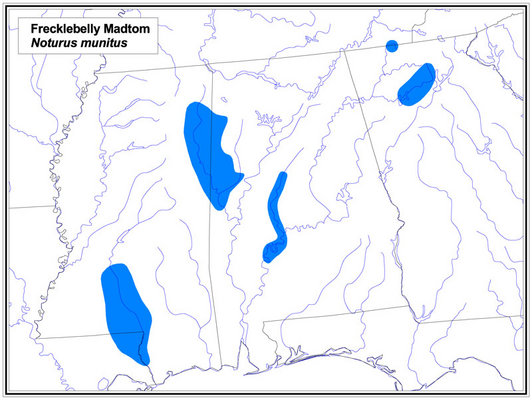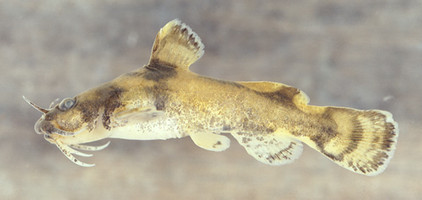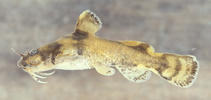Noturus munitus
Frecklebelly Madtom
Larry PageIdentification
The Frecklebelly Madtom has a stout body with the deepest point located beneath or in front of the dorsal fin. The body is yellow to dark brown with dark mottling above and 4 dark saddles. There are large light spots in front of the dorsal fin often incompletely enclosed by dark pigment. The belly usually has dark specks. The fins are mottled or blotched and the dorsal fin has a broad dark band near the clear edge. The caudal fin has 2 dark crescent-shaped bands; 1 near the middle and 1 near the clear edge. The adipose fin has a dark brown or black band extending to the edge. The pectoral spine is large with 5-10 large teeth on the rear edge and large teeth on the front edge. The caudal fin is straight or slightly rounded and nearly free from the adipose fin. The anal fin has 12-15 rays. To 3 ¾ in. (5 cm) total length.
Range
The Frecklebelly Madtom is found in Gulf Slope drainages in highly distinct populations: in the Conasauga River, southeastern Tennessee; Etowah River, northern Georgia; Cahaba-upper Alabama River, central Alabama; Tombigbee River, western Alabama and eastern Mississippi; and Pearl River, southern Mississippi and eastern Louisiana. The species is generally uncommon and is declining in the Mobile Bay drainage due to dam construction and stream channelization.


Distribution of Noturus munitus. © Larry Page
Habitat
The Frecklebelly Madtom inhabits rocky riffles of small to large rivers. Most individuals are found in or near aquatic vegetation.
Similar Species
The Northern Madtom, Noturus stigmosus, lacks brown specks on the belly, has a dark band confined to the lower half of the adipose fin, 2 light spots in front of the dorsal fin enclosed by darker pigment, and a dark crescent-shaped band in the middle of the caudal fin that extends forward across the upper and lower caudal rays to the caudal peduncle. The Piebald Madtom, N. gladiator, lacks brown specks on the belly; has a bolder pattern, a dark bar in the adipose fin connected to the dark bar in the anal fin, a dark crescent-shaped band in the middle of the caudal fin joined to the dark pigment on the caudal peduncle forming 2 distinct yellow spots at the base of the fin. The Neosho Madtom, Noturus placidus, lacks prominent saddles and dark specks on the belly, has small teeth on front of the pectoral spine, white lower front caudal rays, and a dusky band confined to the lower half of the adipose fin.
About This Page
Larry Page

Florida Museum of Natural History, Gainesville, Florida, USA
Correspondence regarding this page should be directed to Larry Page at and Griffin Sheehy at
Page copyright © 2007 Larry Page
All Rights Reserved.
- First online 23 May 2007
- Content changed 23 May 2007
Citing this page:
Page, Larry. 2007. Noturus munitus . Frecklebelly Madtom. Version 23 May 2007 (under construction). http://tolweb.org/Noturus_munitus/69872/2007.05.23 in The Tree of Life Web Project, http://tolweb.org/








 Go to quick links
Go to quick search
Go to navigation for this section of the ToL site
Go to detailed links for the ToL site
Go to quick links
Go to quick search
Go to navigation for this section of the ToL site
Go to detailed links for the ToL site